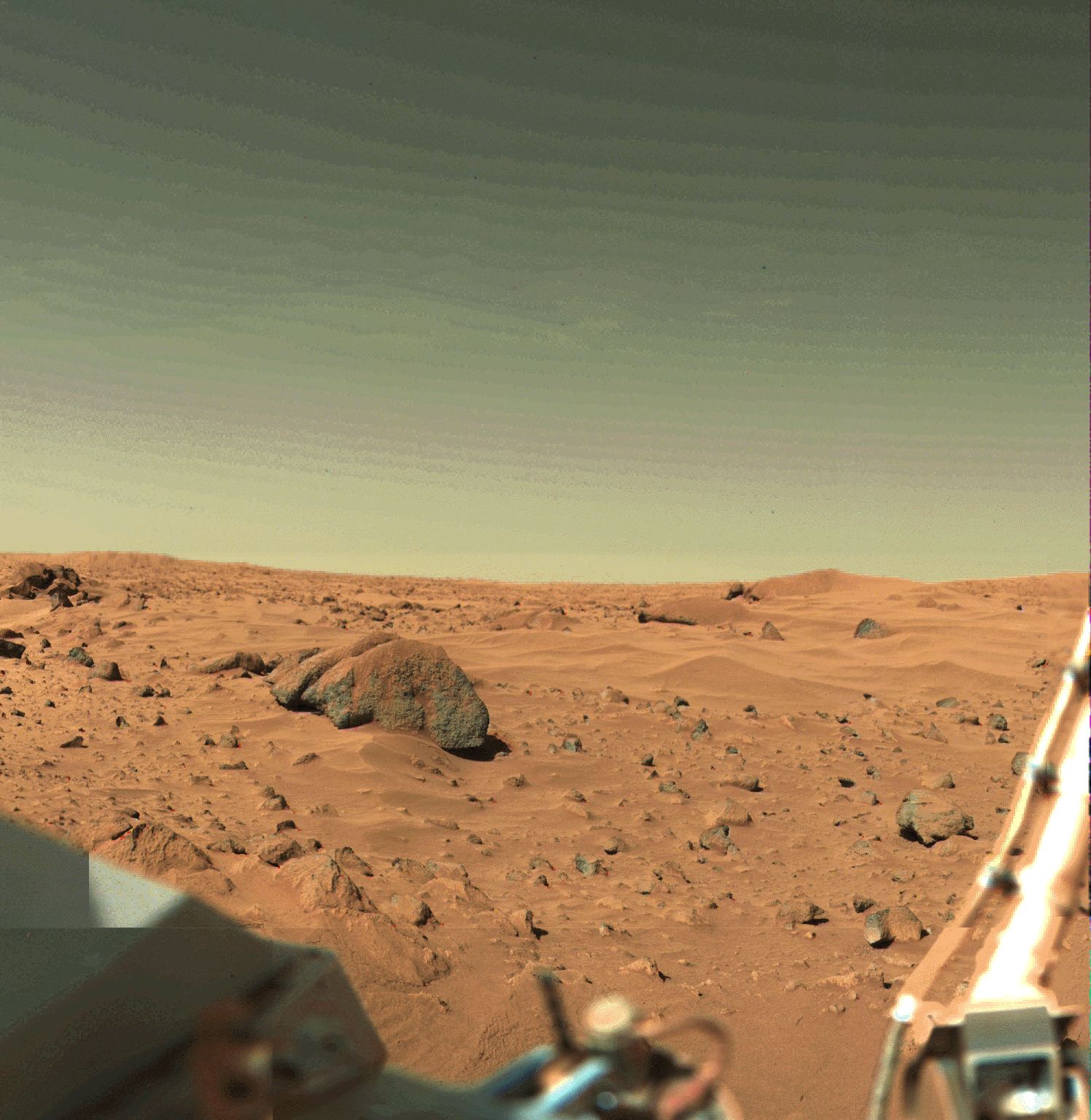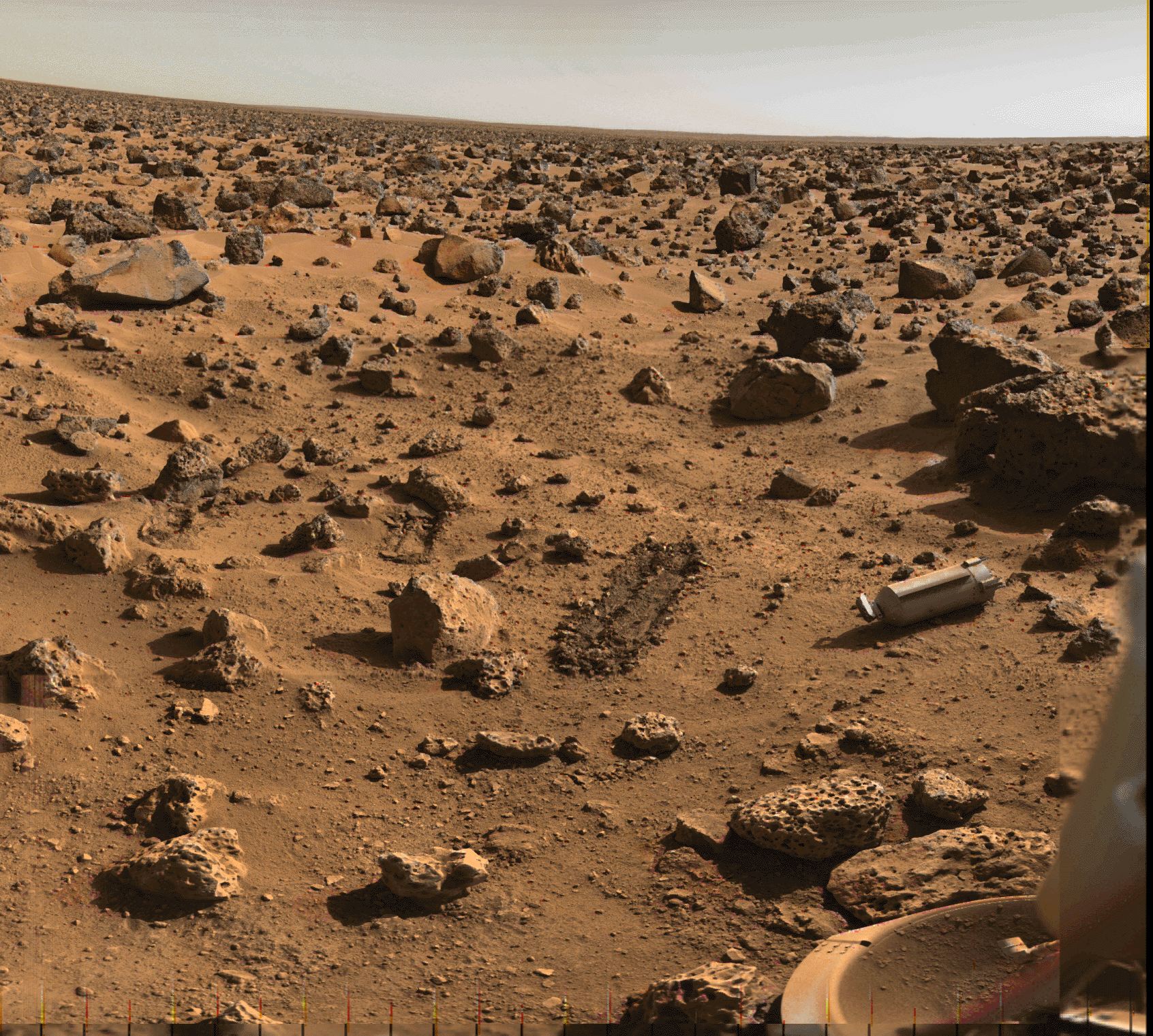I did not foresee that my claim that the Martian sky is not red, at least, that the photographs showing a completely reddish planet are strongly exaggerated, would start a flow of email, some thanking me for bringing that topic out, other much more critical. Here is an example and my answers.
Of course you should first have read the main page on that topic, and the final page in the end.
Subj: Just some data about Martian sky.
Date: 28.07.2002 20:53:44 Romance Daylight Time
From: xxxx@wanadoo.es (Dxxx Gxxxx)
Hello,
My name is David, and I would like to share my knowledge about the Martian atmosphere and its 'reddish' color. It is thought that Martian Sky is red because of dust (> 1 micron particles) suspended in the atmosphere.
RE: David:
I almost agree: it is thought that when the Martian sky is brownish, it is because of the dust. There are long and massive dust storms on Mars, and under such conditions, the sky is obviously not blue.
I agree with you that it is not as red as it appears in the Viking photographs (they were incorrectly tuned) but not with the Pathfinder ones. I own truly copies of the original images from the Pathfinder mission and your digital copies seem way too red to me.
(I wrote exactly that in the page David criticized, but he obviously did not read properly).
RE: This is exactly one of my points: images of the sky of Mars are too reddish, much too reddish sometimes, and ridiculously too reddish on occasion. Mostly on images that are spread by the mass media, whereas original NASA images are often less reddish. Some of them do show the blue sky I am discussing.
As for Pathfinder images, Hubble Release 97-148 (scientist Don Savage and his team) wrote:
"(...) If dust diffuses to the landing site, the sky could turn out to be pink like that seen by Viking," says Philip James of the University of Toledo. "Otherwise, Pathfinder will likely show blue sky with bright clouds. (...)"
But your 'corrections' are not accurate.
RE: Nobody can tell. Maybe they are, maybe not. The idea behind these corrections is as follows: A Vince Di Petro NASA guy made a fuss about NASA pics, and claimed there is 30% too much red and 15% too much green added. I simply decided to have a look when I decrease these values. I found out that many pictures are not that reddish anymore, and that they match the "not so red" aspect of other NASA pictures:
marscol10.jpg
marscol11.jpg
marscol12.jpg
If Di Pietro was wrong in his claims, my corrections would possibly have resulted in less interesting images.
In fact, Martian Sky changes its color as the Earth Sky changes its own with the time of day and the special characteristics of the atmosphere.
RE: Ok, I am aware of that. I know that the sky is dark at night, grey when there are clouds in daytime, red at sunset and so on. My point was not to claim that the sky on Mars is never red and always blue, it was to claim that the sky is 1-not that red, the red being an overall exaggerated correction, and 2-blue, in the middle of the day and when there is no dust storm.
The sky on Earth is blue mainly because it is composed of 78% Nitrogen and 21% Oxygen. On the other hand, the sky of the Red Planet is composed of 95% of CO2 and 3% Nitrogen.... if this composition was pure (I mean, the last 2% made up of Nitrogen or CO2) we would get a sky of pale grey. But there is another factor in this equation, that is, pressure. The pressure on Mars atmosphere is between 7 and 9 mb, while on Earth is 1014 mb, that means the sky on mars is much darker than the one on Earth.
RE: No.
The skies, whether on Mars or on the Earth, are to be blue. The blue color is NOT an effect of the composition or the pressure, it is due to a phenomenon called Raleigh scattering. Not a lower density, but a higher density would result in a red sky. To get a red sky, you need a very non-Martian atmosphere, tainted with hydrocarbonates.
Scientist Dan Shepherd, of the Chemistry and Science Faculty of Bluffton College explains nicely that a red sky is only possible if you have a much denser atmosphere than the Earth has, or an atmosphere tainted by complex molecules such as photochemically generated hydrocarbonates. But we have been told that the Martian atmosphere has less than 1% of the terrestrial atmosphere density, and that there is no organic matter on Mars, allegedly.
Dan writes:
"To see a red sky all around, one would need either a much thicker atmosphere (in which case it's dubious whether any light would get through at all) or an atmosphere rich in compounds which preferentially absorb blue light. It is actually thought, I believe, that Titan may have a red sky due to the high concentration of more-or-less complex hydrocarbons (photochemically generated) in its atmosphere."
But, nobody has yet gone to Mars, and nobody has seen the sky with its own eyes. And, to answer one of the questions you made, yes, this is science."
RE:
No it is not. It is only random colorization. Look again:
These are all Mars pictures from NASA web sites and NASA related web sites. This colorization is not science to me. If it is science to you, well, no problem, we have different opinions...
But, really, would you really think these nice NASA colors are serious (come on, have a look, it's really fun:
Green:
http://nssdc.gsfc.nasa.gov/image/planetary/mars/vikinglander1-1.jpg

White:
http://nssdc.gsfc.nasa.gov/image/planetary/mars/vikinglander1-2.jpg

Yellow:
http://spacelink.nasa.gov/NASA.Projects/Space.Science/Solar.System/Viking/Viking.Orbiter.Images/Mars.Frost.gif

http://nssdc.gsfc.nasa.gov/imgcat/html/object_page/vl1_12b069.html
Pink/grey:
http://nssdc.gsfc.nasa.gov/image/planetary/mars/vikinglander2-2.jpg

http://grin.hq.nasa.gov/IMAGES/SMALL/GPN-2000-000426.jpg

Red:
http://nssdc.gsfc.nasa.gov/imgcat/html/object_page/vl1_11d128.html
http://cass.jsc.nasa.gov/images/sred/sred_S30.gif

Orange:
http://nssdc.gsfc.nasa.gov/imgcat/html/object_page/vl2_21c056.html
Blue/white:
http://cass.jsc.nasa.gov/images/sred2/sred2_S30.gif

And that's all NASA work. Look at pics in magazine and on TV: it's all red, red, red...
Now, maybe you should consider again what scientists really say:
QUESTION:
If the winds of Mars were completely calm, so that no dust particles were stirring, what color would the Martian sky have at midday and at dusk? Does this ever happen?
ANSWER from Mary Urquhart on July 14, 1997:
A good question. You are perfectly correct in thinking that an absence of dust will change the color of the Martian sky. Without any dust in the atmosphere the sky would probably be a dark blue at midday (darker than the Earth's sky because the atmosphere is much less dense and so there are fewer air molecules to scatter blue light. At dusk the sky would probably have a slight reddish hue in the west, particularly if the Martian clouds were reflecting sunlight. The reason for the reddish color would be the same as on the Earth. Gas molecules scatter blue light and when you look at the Sun at sunset you are looking through more gas because the Sun is closer to the horizon. With the blue light scattered out, the remaining light is reddens. Once again, this effect will be slight compared with the Earth because there is less gas in the atmosphere of Mars. Mary Urquhart
Laboratory for Atmospheric and Space Physics
University of Colorado at Boulder
ANSWER from Jim Murphy on July 15, 1997:
This is a great question about Martian sky color and suspended dust, and we here on the Pathfinder meteorology team have spent quite a bit of time talking about it. If the Martian atmosphere were completely clear of dust, I think that the sky would be quite a bit darker than clear skies here on earth. If you have ever flown on a plane at 30,000-35000 feet during daytime, and looked at the sky, you might have noticed that it appears much darker than from the surface, especially when you look at particular angles away from the sun. This darker appearance is due in part to the reduced scattering the light experiences at these high altitudes (low air pressures like on the surface of mars!!) compared with the much greater numbers of molecules the sunlight can 'bump' into on its way to the surface. Blue light is scattered more effectively by molecules than is the longer wavelength red light, which is why the sky looks blue.
I don't expect that the Martian atmosphere will clear substantially during Pathfinder's mission on the surface. In fact, I expect the atmospheric dust content to increase as summer gives way to autumn. But, if the atmosphere were to clear (I've blown forecasts before :-) ), the sky would be bluer, but not the light blue that we see on a terrific day here on Earth. It would be a beautiful picture of Mars, however.
Thanks for the question.
Jim Murphy
Mars Pathfinder ASI/MET Science Team
Subj: RE: Re: Just some data about Martian sky.
Date: 23.08.2002 01:41:33 Romance Daylight Time
From: xxxx@wanadoo.es (Dxxx Gxxxx)
It's me, David again.
Thank you very much for your email. I truly feel very grateful about that. And after the information you have shared with me I think I will have to reconsider my position about the appearance of Martian sky.
I feel sorry if my previous mail was considered an offense. Anyway, I will continue asking myself if things are as correct as they appear to be.
Yours,
David.
RE: Hi David,
Really, there is no offense. I know that the whole idea of a blue sky on Mars sounds terribly like a crackpot idea ;-) As a matter of fact if anyone had told me the Martian sky may be blue not red before I researched that myself I would probably have said what you said in your email...
Keep on doubting, and take care.
Patrick